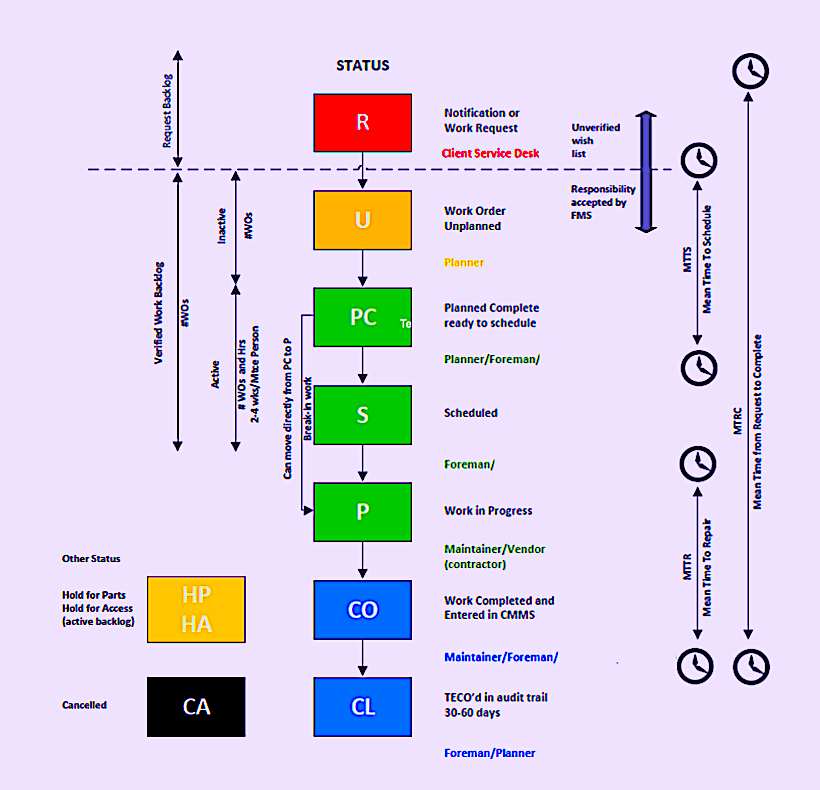W. Edwards Deming once stated, “In God we trust, all others must bring data!” For some, data is a four-letter word, and the value of collecting and recording it and the evidence associated with an asset failure event is often poorly understood. Old-school thinking dictates that we “get the asset back up and running, and get on to the next job ASAP.” The reality is asset management software (AMS) systems and computerized asset management software (CMMS) systems both employ the word “management.” They also rely almost completely on the capture of post-work data to capitalize on its designed ability to convert and translate the collected data into meaningful evidence-based informational trends and reports. Those trends and reports are, in turn, used daily by planners, schedulers, foremen, managers, clients, and stakeholders to confidently perform agile, evidence-based decision-making.
Once the maintainer leaves the job site, the opportunity to reliably collect and record the scene is lost forever. Think of the criminal justice system where CCTV (closed-circuit TV) or cell-phone photographic evidence always trumps the hearsay memory of an eyewitness after the fact. The longer the time between the event and recall, the more hearsay evidence is mistrusted and based on character rather than conclusive data based on photographic evidence or a written account that’s recorded at the actual time of the event.
From the perspective of asset-life-cycle reliability, availability, and maintainability (RAM), collection and documentation of findings, work details, and data at the job site is arguably the most critical point in the maintenance-work process. In the absence of that collection and documentation, the AMS or CMMS is relegated to a mere work-order print and repository engine with little or no management value.
WORK ORDER BREAKDOWN: COMPETION SECTION
FINDINGS/COMMENTS/FIELD NOTES. . .
This is where the maintainer gets to execute and incorporate best practice action through the documentation and capture of qualitative notes and improvement ideas that spell out a narrative of findings, evidential materials, conclusions and recommendations; all or any of which can be incubated at any time in the future. See my RAM article “Planning for Failure, and its Investigation” for further details.
How the maintainer’s notes and comments are laid out will depend greatly on the design layout and flexibility of the AMS/CMMS. Sometimes, the software will allow text to be formatted into a list that can be cross-referenced to an electronic companion document, photo, SCADA reading/report, alarm report, scanned field notes, etc.. Older software may be rudimentary and offer only a text field with a fixed number of allowable characters. Such constraints can be managed with a data-collection protocol/SOP, wherein the accompanying data is placed in a separate controlled maintenance data file referenced in the work order’s close-out-comment area.
PHOTOGRAPHIC ATTACHMENTS. . .
With the advent of cell phones, tablets, and inexpensive data-storage memory, photographs are easy to take, document, link, and store. Photos taken from multiple angles allow a planner to remotely view the work site and plan work remotely.
Photographs taken before and during the failure investigation or repair (combined with a box of actual failed parts) allow a reliability engineer to perform a remote failure investigation; compare similar failures to determine patterns; and work with the planner to determine if the current Preventive strategy is working. Photographs taken after a repair prove the work has been performed and that the job site was left clean.
When taking photographs of the apparent damage or workplace scene, photographing from different angles helps document the scene from both the requestor’s point of view and a maintenance-planning perspective. For example, when a requestor calls in with the somewhat ambiguous statement “area is flooded,” a set of photographs of the area containing the standing water will show what he or she sees as the problem. Conversely, photographs of the scene based on the maintenance viewpoint will document the damage at the leak’s source, e.g., a damaged pipe or valve allowing water to flow unabated, as well as the residual damage caused by the leak that must now also be repaired, e.g., walls, floor coverings, electronics, etc. All photos should include a reference scale of measure, e.g., a six-inch rule.
If the client /stakeholder is unable to be physically informed at the time of work completion a photograph of the completed work scene should be sent immediately to their contact address to inform them the work has taken place and their asset is once again in service.
PARTS USED. . .
Even if parts were issued with the planned work order, all unused parts need to be adjusted for on the work order and returned. Furthermore, any additional non-stock or spot-buy parts purchased for the work and charged to the work order must be captured on the work order and entered into the work history
WORK COMPLETION TIME. . .
Once the repair is finished, the job site is cleaned up, and the work order details entered, the work order is complete and must be time stamped. This time stamp is used to calculate the ACTUAL time to complete work, used to compare against the ESTIMATED time for time variance reporting, as well as to calculate the Mean Time To Repair (MTTR) indicator.
For time reporting, maintenance must have a clear set of rules to determine how actual work time is recorded and how non-“wrench-time” work is managed, recorded, and charged back to maintenance or the client. Time spent to carry out the completion of a work order can include:
♦ actual work time
♦ travel time to the job, the next job, or for parts
♦ waiting time for parts/tools
♦ waiting time for machine, client or access to asset.
The actual estimated planned-work time is the only constant for planning purposes. All other times need to be accounted for as part of the scheduling process, and can vary on every job. How the time is managed, collected, and charged will depend on the type of business and geography; how well maintenance is set up to provide parts and tools; and the service-level-agreement expectations between maintenance and the client/stakeholder.
FAILURE SYMPTOMS. . .
Some AMS/CMMS systems provide drop-down or pick lists that allow the user to make the most appropriate choice. The “Symptoms” list is usually a good candidate for this type of software feature. Keep in mind there could be one or more choices that are relevant. Accordingly, they all need to be accommodated for this to be a useful list in helping determine the root failure cause, e.,g., heat (bluing/scorch marks), leak, jamming, excessive vibration, looseness, vandalism, etc. If more than one choice is required, it should be added to the findings text. All symptoms should be backed up with an appropriate reference photograph.
FAILURE CAUSE. . .
It is often very difficult to assess the true cause of failure without further investigation of parts, production data, historical maintenance data, and the like.. Moreover, it is generally not the purview of the maintainer, but rather that of the reliability engineer to perform a root-cause analysis of failure (RCAF)
However, the maintainer is eminently qualified to identify if the failure was maintenance related/caused, or if it was a non-maintenance related/caused failure at this stage. Employing this simple, yet powerful choice to filter all work history into two reports can instantly determine and differentiate work that the maintenance department controls (maintenance related/caused) versus the work that the department merely manages (non-maintenance-related/caused work) and over which it has little or no control.
FAILURE EFFECT. . .
Whenever maintenance work is performed the client/stakeholder will judge our performance based on numerous indicators: how they are informed, If the work is completed satisfactorily, how long it took, and, most important, how it affected their ability to carry on working. The service maintenance delivers is primarily asset availability and reliability ensuring minimum loss of service to the client /stakeholder.
Documenting one of four service loss scenarios to determine the failure effect at the time of event provides a simple data filter that allows maintenance to provide proactive reporting on its level of service to clients and stakeholders. This documentation backs up, with tangible evidence of the events, whether the event was maintenance-caused or not. These simple four report or data filters (No loss of use/Partial loss of use (slowdown or partial downtime)/Full loss of use) form the basis of a powerful, yet simple client/stakeholder service level agreement in tangible terms easily defined by the maintainer at the job site.
With the work complete, the work-order status changes from IN PROGRESS to COMPLETE, which means it is now in the system as essentially closed, but still retains the ability to have additional charges added to it. Such changes might include, for example, a late invoice identifying cost of items purchased and used for the work that need to be accounted for against the work order for reconciliation and payment purposes. If the work order is a master (or control) work order used to manage multiple trades working on the failure event, all sub work orders must be completed before the master, i.e., control, work order can be completed (see Fig. 1 below).

Fig. 1. Work order status flow
(Copyright EngTech Industries, Inc.)
After a period of time, often referred to as the “sunset period” (usually between 30 and 90 days), the work order can be set up to automatically or manually change status from COMPLETE to CLOSED. The CLOSED status locks a work order into history with a closed audit trail, meaning it cannot be changed in any way and completes the work order/management cycle.
Closed work orders are somewhat like tea leaves to a psychic, in that they provide quick insight into how a maintenance department operates and understands its business. When seeking to understand and document a maintenance department’s current state, it is the closed-work-order file that is used to extract reports, trends, and the relevant information needed to paint the current picture.
A quick review of the job plan/work instruction section of closed work orders versus the accompanying closing comments section, notes and photographs, and level of WO completion sheds light on some very important things. They include how well a job is planned, and how work is performed in comparison to the published workflows, processes and procedures. This provides dramatic insight into how the maintenance department expects to run versus how it actually does run.
FINAL THOUGHT
Remember this: Every work order tells a story. That said, what story do you want your work order to tell?TRR
Editor’s Note: Click The Following Links for Recent Work-Order-Related Articles by Ken Bannister:
“Maintenance Work Orders: The Request” (April 10, 2020)
“Understanding, Classifying, and Tracking Work” (June 5, 2020)
“Make Work Orders Work” (August, 15, 2020)
“Make Work Orders Work: The Job Plan” (August 20, 2020)
Make Work Orders Work: The Work Instruction (August 29, 2020)
ABOUT THE AUTHOR
Ken Bannister has 40+ years of experience in the RAM industry. For the past 30, he’s been a Managing Partner and Principal Asset Management Consultant with Engtech Industries Inc., where he has specialized in helping clients implement best-practice asset-management programs worldwide. A founding member and past director of the Plant Engineering and Maintenance Association of Canada, he is the author of several books, including three on lubrication, one on predictive maintenance, and one on energy reduction strategies, and is currently writing one on planning and scheduling. Contact him directly at 519-469-9173 or kbannister@theramreview.com.
Tags: reliability, maintenance, availability, RAM, work management, work order, job plan, work instruction, checklist, data collection, maintenance workflow, asset management



